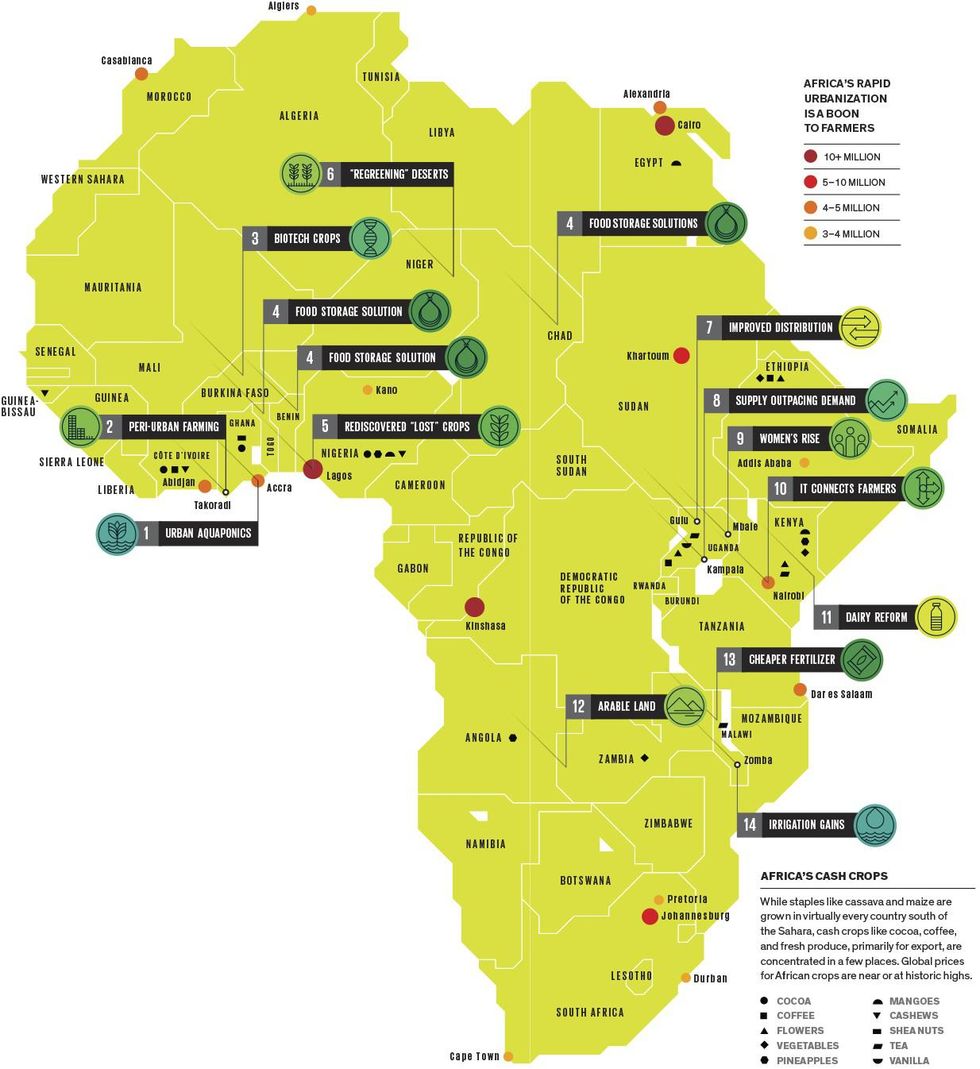If you haven’t been tracking developments in African agriculture lately—and unless you’re an economist or working for a nongovernmental organization or something, why would you?—then you may have missed the big news: For the first time in a half century, farming in Africa, particularly in the sub-Sahara, is booming.
The Bill & Melinda Gates Foundation, the leading nongovernmental donor to African agriculture, reports that 10 sub-Saharan countries are posting annual output increases of 6 percent, more than twice the rate of population growth. Even infamously food-insecure Malawi and Ethiopia now grow enough to export surpluses to their neighbors. And the most densely populated western part of the continent has sustained such profound gains that Steven Wiggins, a leading expert on agriculture, has declared that “a green revolution is already under way.”
Some readers may find that statement incredible. And indeed it’s hard to shake those haunting images of starving Africans from decades past. But the stories emerging these days from the sub-Sahara speak of real change and innovation—and the potential for greater gains in the future. Here are a few examples.
1. Accra, Ghana — Urban Aquaponics
Growers in Ghana’s largest city raise organic lettuce, tomatoes, and other produce indoors. Being close to customers means that transportation expenses and spoilage are minimal. Prices are comparable to those in developed countries, making the payoff large, despite high equipment and electricity costs.
2. Takoradi, Ghana — Peri-urban Farming
Enterprising farmers cultivate once-idle land on city perimeters and then transport their goods by taxicab and bicycle to the central market, just a few kilometers away. As Africa rapidly urbanizes, farmers in and close to cities are thriving, while those in more remote areas now have greater access to farmland.
3. Burkina Faso — Biotech Crops
Burkina Faso, one of Africa’s poorest and most arid countries, is also one of its leaders in genetically modified crops. The mass introduction of GM cotton in 2010 has lifted yields and reduced costs for tens of thousands of farmers. With their gains, farmers can invest in productivity enhancements for other crops.
4. Togo, Benin, Chad — Food Storage Solution
Weevil infestations of cowpeas, a plentiful staple in the hot, dry Sahel region, cause postharvest losses as high as 50 percent. Researchers at Purdue University created an airtight triple-layer sack that stops the bugs cold. Last year, the sacks were distributed to 28 000 villages in 10 African countries.
5. Nigeria — Rediscovered “Lost” Crops
Production of cassava, sunflower seeds, and cowpeas has rapidly expanded throughout the sub-Sahara in the past two decades. In Nigeria, cassava output tripled to reach 90 million metric tons per year from the mid-1980s to the mid-2000s. A million tons can meet the cassava needs of 22 million Africans.
6. Niger — “Regreening” Deserts
By trapping drifting soil and then planting trees near food crops, farmers in Niger are reclaiming land that had been lost to desertification [PDF] and aiding in the regreening of this poor and arid country.
7. Gulu, Uganda — Improved Distribution
Moving food within the sub-Sahara from regions of surplus to regions with shortages remains a challenge. Uganda and South Sudan eliminated official barriers to food trade [PDF]—a boon to farmers in northern Uganda.
8. Kampala, Uganda — Supply Outpacing Demand
In Uganda in East Africa and in 15 West African countries, food production now outpaces population growth, despite the fact that the region has one of the fastest-growing populations in the world.
9. Mbale, Uganda — Women’s Rise
Peanut farmer Jessica Sakwa is among a rising class of women farmers in Africa who manage their own fields and reap the rewards of their crop sales. African women do most of the farming, and so improvements in their education and status have a direct impact on farm productivity.
10. Nairobi, Kenya — IT Connects Farmers
VP Group, a multinational food broker, collects green beans and other vegetables from thousands of small farms, quickly sorts and packs them, and then trucks them to the airport, where they’re flown to Europe. Text messaging (connecting farmers to the buyer) and bar coding (tracking inventories in transit) make the operation efficient.
11. Kenya — Dairy Reform
The Kenyan government pushed through reforms in milk processing and marketing of milk and funded research on hardier, more productive cow breeds. Kenya’s 5.5 million cows are now the top milk producers in Africa. Uganda and Ethiopia are now studying how to duplicate Kenya’s dairy success.
12. Zambia — Arable Land
Part of the vast Guinea Savannah zone that runs through 25 countries, Zambia cultivates only 15 percent of its arable land. The sub-Sahara generally has the most unused arable land in the world—360 million hectares in the Guinea Savannah alone. More available land means that entrepreneurial farmers have room to expand.
13. Malawi — Cheaper Fertilizer
Corn farmers in Malawi went from bust to boom, thanks to government subsidies for fertilizer and an international aid program that buys corn for shipment to Zimbabwe. Very little African farmland is fertilized—it’s the lowest rate in the world—and so affordable fertilizer can yield dramatic results.
14. Zomba, Malawi — Irrigation Gains
In the United Nations’ Millennium Villages district in central Malawi, farmers carry buckets of water into their fields and spoon fluids onto the plants. Given the rarity of fixed irrigation in Africa—by far the world’s lowest rate—such low-cost ways of watering crops are gaining ground, and yields are climbing.



